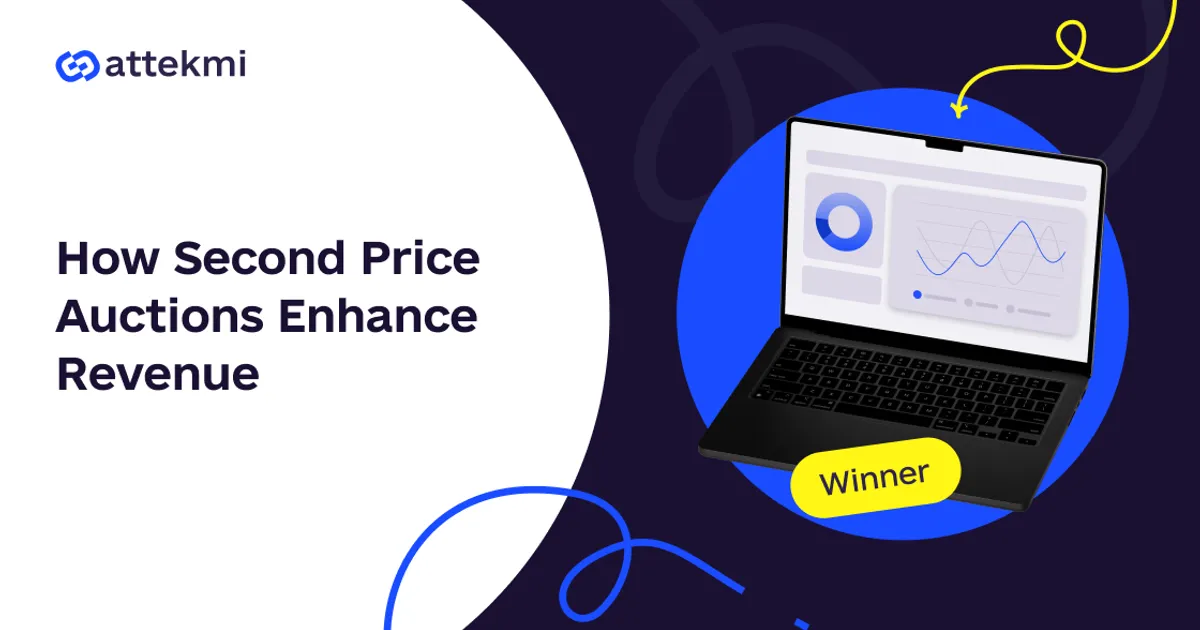Programmatic advertising offers multiple models, and second price auction is among them. Is it better than other approaches? To keep a long story short, yes. But what is a second price auction, and how can it help drive revenue? In this guide, you will find answers to these and other questions.
Second price auction: the definition
So, let’s start with the description of the second price auction model. To get a better understanding of how it works, take a look at the following second price auction example:
The first advertiser bids $2
The second advertiser bids $3
The third advertiser bids $3.15
The highest option is obviously $3.15, and it wins. However, the winner doesn’t pay this amount. Instead, they pay $3.01 for ad impressions — $3 (the second highest amount) plus $0.01. Basically, the highest bid wins, but an advertiser pays less in the end.

Economic theory and behavioral insights
The profitability of the 2nd price auction is supported by economic insights. Thus, its basis is the Vickrey auction — the participants place their bids without knowing the stakes of others, and the winner pays the second highest amount. Such an approach encourages fair and truthful bidding since the stakes reflect the exact amount the advertisers are willing to pay for impressions. Additionally, it helps prevent overpaying and remain competitive.
Another benefit of a second bid auction is that it allows for reducing bid shading. This technique enables marketers to save money in the first price auctions since the algorithms automatically calculate the most optimal amount. However, for publishers, this usually means a decrease in profit.
But when it comes to second price bidding, the process itself gets more transparent and genuine. For advertisers, the risk of overpaying is still low since winners pay just a bit more than the second bid. At the same time, publishers can monetize their inventory effectively, meaning that the second price auction is a win-win situation for all the parties involved.
However, it is still important to keep in mind certain problems with second price auctions. For website and app owners, first price auctions are often more beneficial since the highest stake wins, and they get exactly this amount for their inventory. The alternative approach is a compromise, which explains why a second price auction is better for everyone. Meanwhile, the hidden disadvantages should still be kept in mind. Publishers have to analyze the profitability of their inventory continuously and adapt their strategies according to the collected insights.
Revenue enhancement mechanisms
Despite certain nuances, 2nd price auction offers multiple revenue enhancement mechanisms for publishers and advertisers, so let’s explore them in detail.
Bidder trust and participation
In second price auctions, advertisers place bids that reflect the amount they are willing to pay. The process becomes more transparent and honest, which allows for building trust among the auction participants. As a result, such auctions attract more marketers, which leads to increased competition and higher revenue for publishers. In turn, advertisers can analyze their competitors and experiment with different amounts to identify the most optimal options and refine their strategies.
Bid optimization
Bid shading helps advertisers spend less, but so does second price bidding. During such auctions, advertisers bid their real value but still pay a lower amount in case they win. This ensures bid optimization so that marketers can save their budgets and plan more thoroughly.
For publishers, this can still be less beneficial than the first price auctions, but, again, the second price approach is a compromise for everyone. Advertisers place optimal bids while publishers still get their revenue. Moreover, the 2nd price approach encourages more aggressive bidding so that publishers can monetize their ad space with no income losses.
Dynamic pricing
Additionally, the second price auctions have a dynamic nature, meaning that the prices reflect the current market demand. For publishers, this is an advantage since they can maximize their revenue potential and sell their inventory at an optimal cost. Other important factors include performance data and competitors’ behavior. For example, advertisers may adjust their bids to remain competitive, which allows publishers to drive income.
Bid floor
To ensure transparency and receive stable income, publishers can set up a bid floor, a minimum amount that auction participants must meet. Such an approach enables them to prevent potential profit decreases while advertisers compete on equal terms and can allocate budgets properly from the very beginning.
Consider Attekmi your trusted partner
Both first and second price auctions are popular among advertisers and publishers, even though it is still essential for them to learn how to make the most of these models and come up with relevant strategies. In any case, owners of ad exchanges have to meet their needs. Creating a platform with the second price auction functionality from scratch is time-consuming and expensive, but Attekmi solves this challenge for you.
Instead of developing everything on your own, you can opt for an ad exchange solution and start earning on media trading in one week. The Attekmi solutions support both first and second price models, and multiple settings allow for matching supply and demand partners effectively. For instance, Phonder grew its revenue by 87.47%, and you can reach the same heights. Additionally, you can benefit from the adaptive margin feature — this functionality automatically calculates the most optimal margin and helps you maximize revenue.
Does Attekmi look like the right choice to you? Then let’s get in touch!
FAQ
First price vs second price auction. What is the difference?
In the first price auction, an advertiser who placed the highest bid wins and pays the exact amount they bid on. In the case of the second price auction, the highest bid still wins but a marketer pays the amount of the second highest bid plus typically $0.01.
Is second price bidding more beneficial for publishers than the first price model?
During the first price auctions, publishers get paid according to the highest winning bids. As for the second price auctions, the highest bid still wins, but an advertiser pays less. At the same time, the second price model implies more aggressive and transparent bidding so that publishers can still monetize their inventory efficiently.
What are the main benefits of the second price auction model?
The main advantage of second price auctions is more truthful and transparent bidding. Advertisers place exactly those bids that they are willing to pay, while the risk of overspending is significantly reduced. This implies more effective budget planning, while publishers often get access to more active bidding.
 By Anastasiia Lushyna
By Anastasiia Lushyna